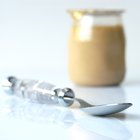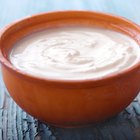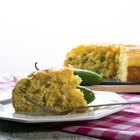
At the table, plain yogurt can be used as a lower-fat alternative to sour cream in many dishes. Yogurt also can be substituted for sour cream in baking, either to reduce the recipe's fat content or because you find yourself out of sour cream at the crucial moment. For example, you could use your vanilla-flavored breakfast yogurt in a sour cream coffee cake, with a few adjustments to the recipe.
The Basics
Both yogurt and sour cream are cultured dairy products made through a similar process. Dairies add a bacterial culture to warmed heavy cream to create thick, slightly tangy sour cream. Yogurt uses a different kind of bacteria to give whole or partially skimmed milk a similarly thick texture. Natural and Greek-style yogurts are thickened entirely through bacterial action, while commercial brands often add gelatin or other stabilizers to extend the yogurt's shelf life. Some varieties include vanilla, fruit or other flavors, and can be sweetened.
Vanilla Yogurt
Before you pour vanilla yogurt into the mixing bowl, it's important to review a few details. First, it's a lot lower in fat than your sour cream. Sour cream is typically around 35 to 38 percent fat, like whipping cream. Yogurt is around 4 percent fat. That's great from the dieter's perspective, but that fat is part of what makes your cake tender. Vanilla yogurt is often sweetened to bring out the vanilla flavor, so you'll also have to allow for both the sweetness and the vanilla flavor when you bake your cake.
The Adjustments
You can work out the amount of sugar in your yogurt by looking at the nutritional information and either doing the math or just estimating. If the yogurt's sugar-free, that's a little trickier. Start by reducing the sugar by one-quarter, and see how the finished cake tastes. You also can reduce the amount of vanilla your recipe calls for, though that might not be necessary. Compensating for the lower level of fat is more of an issue. If you're making the substitution because of necessity rather than calories, use one or two tablespoons of softened butter or an extra egg yolk along with the yogurt.
Lower-Fat Adjustments
If you're using yogurt to keep the calories down, there are other ways to keep your cake's crumb tender rather than tough. One option is using a lower-calorie unsaturated oil instead of butter to replace some of the fat you'd normally get from the sour cream. For a less-caloric alternative, substitute pastry flour or cake flour for your all-purpose flour. Cake flour's lower percentage of gluten gives cakes a softer crumb.
Related Articles

Greek Yogurt as a Replacement for Sour ...

Can You Substitute Yogurt for ...
Nutrition Information for Onken Yogurt

Whole Milk Vs. Lactaid Milk

Greek Yogurt Instead of Butter in Baking

How to Make Almond Buttercream Frosting

How to Make a White Decorator Icing

Softened vs. Melted Butter When Baking

How to Freeze Yogurt Sauce

What is Healthier: Greek Yogurt or ...

The Amount of Lactose in Yogurt

Facts About Yoplait Yogurt

What Is the Difference Between a Shake ...

Difference Between Yogurt & Curd

The Purpose of Buttermilk in Baking

What Do I Use if I Don't Have Whipped ...

Does All Frozen Yogurt Contain Corn ...
How to Use Yogurt or Sour Cream Instead ...
Water Substitutes for Cake Mix

How to Make Glaze for Donuts With Milk ...
References
- On Food and Cooking: The Science and Lore of the Kitchen; Harold McGee
- The Cook's Thesaurus: Cultured Milk Products
- Joy of Baking: Baking Ingredient Substitution Table
Writer Bio
Fred Decker is a trained chef and certified food-safety trainer. Decker wrote for the Saint John, New Brunswick Telegraph-Journal, and has been published in Canada's Hospitality and Foodservice magazine. He's held positions selling computers, insurance and mutual funds, and was educated at Memorial University of Newfoundland and the Northern Alberta Institute of Technology.
Photo Credits
David De Lossy/Photodisc/Getty Images